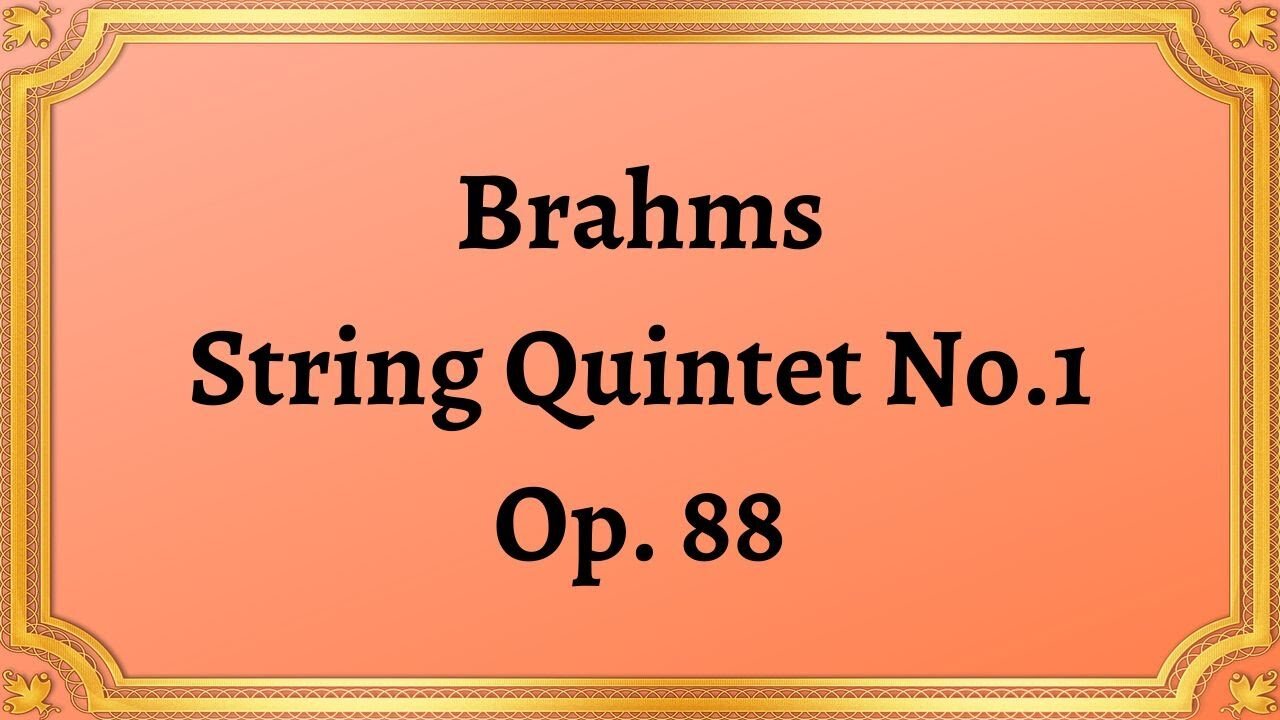Premium Only Content

Brahms String Quintet No.1, Op.88
#Brahms #classical_music#quintet
Brahms String Quintet No. 1, Op. 88 is a four-movement piece of chamber music composed by Johannes Brahms, a German composer and pianist, in 1882. The piece was written for a string quartet (two violins, a viola, and a cello) and an additional viola, giving it a unique sound and texture. While it is perhaps not as well-known as some of Brahms' other works, such as his Symphony No. 1 or his Piano Concerto No. 1, the String Quintet No. 1 is a beautiful and complex composition that deserves attention and appreciation.
The first movement, marked Allegro non troppo ma con brio, begins with a hauntingly beautiful melody played by the first violin. This melody is then passed around to the other instruments, creating a sense of unity and harmony among the quintet. The contrasting second theme is more playful and energetic, with faster rhythms and more intricate harmonies. The movement ends with a return to the first theme, bringing the piece full circle.
The second movement, marked Grave ed appassionato, is much slower and more contemplative than the first. It begins with a mournful melody played by the second violin, which is then echoed and elaborated on by the other instruments. The middle section of the movement features a solo by the first viola, which serves as a kind of bridge between the opening and closing sections. The movement ends with a return to the original melody, but in a slightly altered form.
The third movement, marked Allegro moderato ma con fuoco, is more lively and upbeat, with faster rhythms and more complex harmonies. The main theme is played by the first violin and quickly passed around to the other instruments, creating a sense of joyful energy and excitement. The middle section of the movement features a slower and more melodious section, which provides a contrast to the faster sections on either side. The final section returns to the original theme, building to a thrilling climax before subsiding into a gentle coda.
The fourth and final movement, marked Allegro energico, is the most lively and energetic of the four. It features fast rhythms, complex harmonies, and an overall sense of exuberance and celebration. The movement is marked by sudden shifts in tone and dynamics, creating a sense of surprise and excitement. The final section of the movement, marked Prestissimo, is particularly thrilling, with the instruments racing and intertwining in a way that
You have the opportunity to support the channel https://destream.net/live/RadSiarAl/donate
-
 14:44
14:44
Classical music_Music Inspiration
2 months agoLudwig van Beethoven Sonata No. 14 in C-Sharp Minor, Op. 27, No. 2 "Moonlight"
81 -
 32:30
32:30
Stephen Gardner
9 hours ago🚨BREAKING: Trump under INVESTIGATION for Stock Market Manipulation!
69.8K155 -
 59:50
59:50
Motherland Casino
6 hours agoMel x Zofie
34.4K5 -
 44:54
44:54
Ami's House
2 days agoThe Dave Smith Debate is Broken. Here's a Better Way In | Dave's Rogan Appearance
61.7K11 -
 3:47:20
3:47:20
SlingerGames
7 hours agoDiving (get it?) Back Into Subnautica!
35.5K1 -
 58:35
58:35
BonginoReport
12 hours agoFormer Trans Athlete Accepts Biological Reality - Nightly Scroll w/Hayley Caronia (Ep.24) - 04/10/25
160K99 -
 2:48:38
2:48:38
The Sufari Hub
7 hours ago🔴NOT ENDING STREAM TILL I WIN - ROAD TO #1 GAMER ON RUMBLE - #RumbleGaming
16.3K1 -
 1:49:21
1:49:21
Joker Effect
7 hours ago250$$ Giveaway! MOTHERLAND TAKEOVER!
29.2K -
![🔴 MAFIA III [first look]](https://1a-1791.com/video/fww1/21/s8/1/V/_/U/A/V_UAy.0kob-small--MAFIA-III-first-look.jpg) 3:01:30
3:01:30
Fragniac
1 day ago🔴 MAFIA III [first look]
18K2 -
 2:06:26
2:06:26
megimu32
10 hours agoON THE SUBJECT: Movies We Had Zero Business Watching.. But Totally Did!
30.9K2